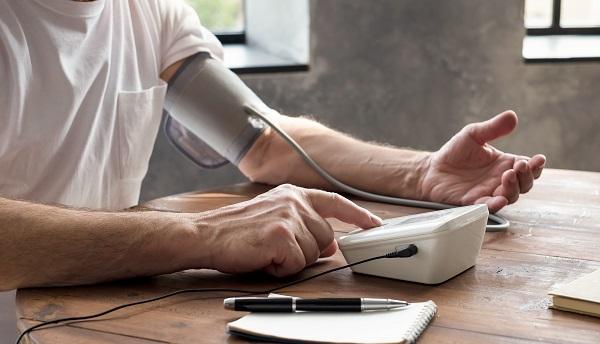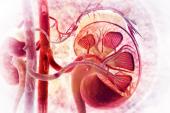Renal Denervation Lowers BP vs Sham Procedure: RADIANCE-HTN TRIO
Renal denervation cut systolic BP by 8.0 mm Hg in patients resistant to meds. One expert still urges lifestyle changes first.

Ultrasound-based renal denervation (Paradise; ReCor Medical) significantly lowers systolic blood pressure when compared with a sham procedure in patients with resistant hypertension treated on a background of antihypertensive therapy, the RADIANCE-HTN TRIO shows.
Renal denervation reduced daytime ambulatory systolic blood pressure by 8.0 mm Hg compared with a 3.0-mm Hg reduction observed in patients treated with the sham procedure, a median between-group difference of 4.5 mm Hg (P = 0.02). Additionally, there were significant between-group reductions in 24-hour ambulatory systolic blood pressure, nighttime ambulatory systolic blood pressure, and office- and home-based systolic blood pressure.
“I don’t want to be perceived as overselling anything, but sham-controlled controls are great for determining if there is an effect or not,” senior investigator Ajay Kirtane, MD (NewYork-Presbyterian/Columbia University Irving Medical Center, New York, NY), told TCTMD. “When you practice in clinical life, you don’t practice with a sham. For me, the more relevant number is the reduction from baseline. An 8.0-mm Hg drop from baseline, especially considering where the patients started from and especially since they were resistant at baseline to medication, to me that’s a meaningful reduction.”
Patients randomized in the trial were all treated with triple combination therapy but still had systolic blood pressures north of 150 mm Hg. For these patients, it is expected they would derive significant clinical benefit from such a blood-pressure reduction, said Kirtane.
“It’s not just what the number is, but where you start from,” he said.
Background of Triple Combination Therapy
In the early days, specifically after open-label studies like SYMPLICITY HTN-1 and HTN-2 where 30-mm Hg reductions in systolic blood pressure were reported, investigators in the field of renal denervation might have been accused of overexuberance. SYMPLCITY HTN-3, a negative study that included a sham-control procedure, tempered a lot of that enthusiasm. Since then, the technology has been refined and a number of studies have shown positive results. With this ultrasound-based device, a catheter is advanced into the renal artery, with operators delivering two or three 7-second circumferential ablations to the renal artery.
Presented as a late-breaking clinical trial at the American College of Cardiology 2021 Scientific Session, the RADIANCE-HTN TRIO trial was conducted at 53 US and European centers and included patients with office blood pressure 140/90 mm Hg or higher despite taking three or more hypertensive medications, including a diuretic. If they were eligible for the trial after initial screening, they were switched to a fixed-dose combination pill that included a calcium channel blocker, angiotensin receptor blocker, and thiazide diuretic. If patients still had a daytime ambulatory blood pressure of 135/85 mm Hg after 4 weeks of treatment with the combination therapy, they were then randomized to ultrasound renal denervation or the sham procedure.
Two months after the procedure, renal denervation reduced several measures of systolic blood pressure, including the primary endpoint of daytime ambulatory systolic blood pressure. When the analysis was restricted to patients with complete ambulatory blood pressure data, the between-group difference between denervation and the sham arm was 5.8 mm Hg favoring denervation.
“This is not in lieu of medicine,” said Kirtane. “To me, that’s a big reset.”
RADIANCE-HTN TRIO: Primary and Secondary Endpoints
|
|
Renal Denervation |
Sham Procedure |
Unadjusted Median Difference |
Adjusted P Value |
||
|
Baseline |
2 Months |
Baseline |
2 Months |
|||
|
Daytime Ambulatory Systolic BP, mm Hg |
150.0 |
141.0 |
151.1 |
146.3 |
- 4.5 |
0.022 |
|
24-Hour Ambulatory Systolic BP, mm Hg |
143.9 |
135.2 |
145.4 |
140.5 |
- 4.2 |
0.016 |
|
Office Systolic BP, mm Hg |
155.6 |
147.1 |
154.9 |
152.1 |
- 7.0 |
0.037 |
|
Home Systolic BP, mm Hg |
152.0 |
144.6 |
153.1 |
149.9 |
- 4.0 |
0.052 |
In terms of safety, there was one access-site complication, a femoral access-site pseudoaneurysm, requiring intervention in the renal denervation arm. In follow-up out to 2 months, there was a sudden cardiac death unrelated to the procedure at 21 days and one transient acute renal injury at 25 days attributed to use of spironolactone in the renal-denervation group.
Kim Williams, MD (Rush University Medical Center, Chicago, IL), one of the co-authors of the 2017 guidelines for the treatment of hypertension, said there is a linear relationship between systolic blood pressure (or mean arterial pressure) and cardiac and neurologic events, “so there’s no question that getting an additional 4- or 5-mm Hg reduction here and there is really an important thing to do.”
He also praised the study investigators for their selection of combination therapy in the trial, a single, fixed-dose tablet that included amlodipine 10 mg (or 5 mg in the event of severe leg edema), valsartan 160 mg (or olmesartan 40 mg depending upon medication availability in each country), and hydrochlorothiazide 25 mg.
However, he said, renal denervation lost momentum many years ago when it was later revealed that patients with resistant hypertension weren’t truly resistant to treatment. Tailoring a drug regimen to the patient’s clinical characteristic, including ethnicity and disease state, performing multiple follow-up visits, and adopting a mostly plant-based diet to increase potassium in diet, decrease sodium, and promote weight loss will see a large number of these “resistant” patients get to treatment goal, said Williams.
He acknowledged that focusing on diet and lifestyle in discussing RADIANCE-HTN TRIO might be a bit of a “sidebar,” but said it speaks to the larger overarching theme: “Why would you do a procedure when you can [change] lifestyle instead and get really good results?” In the trial, the body mass index of patients in both treatment arms approached 33 kg/m2, meeting the definition of obesity, and these patients would lower their blood pressure if they lost weight.
For his part, Kirtane also stressed the importance of different approaches to control high blood pressure. RADIANCE-HTN TRIO trial, he said, is a reminder that hypertension control requires a multifactorial approach—diet, lifestyle, medication, and possibly renal denervation. “The question,” he added, “is whether we have other effective ways to try to lower blood pressure, because it’s a big public health issue.”
Kirtane also emphasized that treatment with the combination therapy was particularly effective at lowering systolic blood pressure levels once patients were switched from their current regimens: he has taken to prescribing the single combination tablet, since patients seem to prefer a single pill.
“I started putting people in my practice on it—those not enrolled in this trial—because adherence is better,” he said.
George Bakris, MD (University of Chicago, IL), one of the discussants, praised the investigators for the use of combination therapy in the trial, saying they’ve been promoting combination antihypertensive treatment since 2003. “I can’t overemphasize that combo therapy as initial therapy in these patients works,” he said. “Adherence—normal adherence is about 45%, but [RADIANCE-HTN TRIO] doubled it.”
Clinical Event Reduction Unknown
While it’s not yet proven that reducing blood pressure with renal denervation will prevent clinical events, the present study shows that the ultrasound-based approach can meaningfully impact systolic blood pressure in a tough-to-treat patient population, said Kirtane. The 8.0-mm Hg reduction in the renal denervation arm was similar to the reduction seen in the RADIANCE-HTN SOLO trial, a study that included patients not taking antihypertensive medication.
In an editorial accompanying the study, Michael Böhm, MD, and Lucas Lauder, MD (Saarland University, Homburg/Saar, Germany), say that a blood pressure reduction of 4.5 mm Hg compared with placebo might seem small but “could be clinically relevant, because in antihypertensive drug trials this decline translates into a 15–20% reduction in major cardiovascular events.” However, like Kirtane, they state that whether blood pressure reductions following renal denervation translate into fewer CVD events needs to be studied.
The editorialists add that there are registry data suggesting the reduction in blood pressure with renal denervation is durable out to 3 years and that it might prove to be yet another tool for physicians who treat hypertension. Studies testing renal denervation for the reduction of hypertension-related complications, they note, are ongoing in patients with heart failure, atrial fibrillation, and chronic kidney disease, populations who have increased sympathetic nervous system activation.
Michael O’Riordan is the Managing Editor for TCTMD. He completed his undergraduate degrees at Queen’s University in Kingston, ON, and…
Read Full BioSources
Azizi M, Sanghvi K, Saxena M, et al. Ultrasound renal denervation for hypertension resistant to a triple medication pill (RADIANCE-HTN TRIO): a randomized, multicenter, single-blind, sham-controlled trial. Lancet 2021; Epub ahead of print.
Böhm M, Lauder L. Blood pressure and renal denervation with ultrasound: another step forward. Lancet 2021; Epub ahead of print.
Disclosures
- Kirtane reports institutional funding to Columbia University or the Cardiovascular Research Foundation from Medtronic, Boston Scientific, Abbott Vascular, Abiomed, Cardiovascular Systems, CathWorks, Siemens, Philips, and ReCor Medical.
- Kirtane reports institutional funding to Columbia University or the Cardiovascular Research Foundation from Medtronic, Boston Scientific, Abbott Vascular, Abiomed, Cardiovascular Systems, CathWorks, Siemens, Philips, and ReCor Medical.
- Lauder and Williams report no conflicts of interest.




Comments